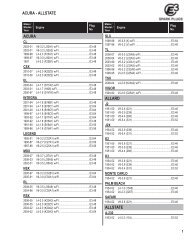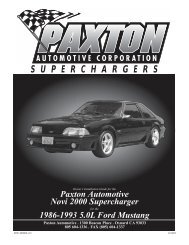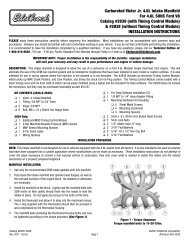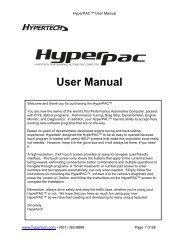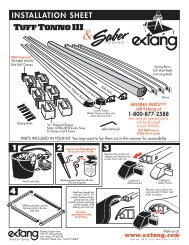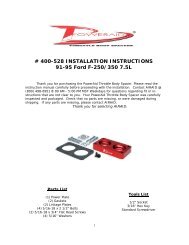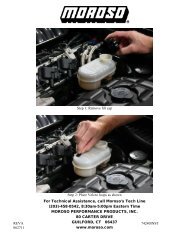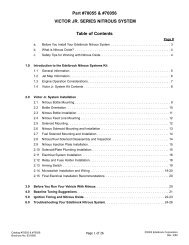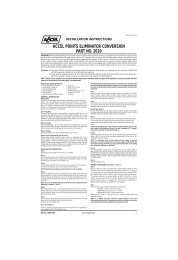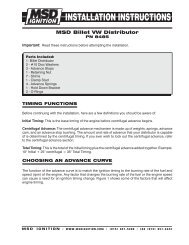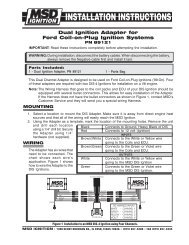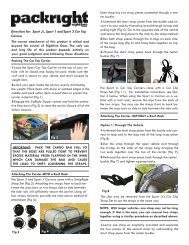NOS 05040 Nitrous System Installation Instructions - Jegs
NOS 05040 Nitrous System Installation Instructions - Jegs
NOS 05040 Nitrous System Installation Instructions - Jegs
You also want an ePaper? Increase the reach of your titles
YUMPU automatically turns print PDFs into web optimized ePapers that Google loves.
How to Read Spark Plugs form a <strong>Nitrous</strong> Oxide Injected Engine<br />
A. Correct Timing, Mixture, and Spark Plug Heat Range<br />
Ground strap retains a “like new” appearance. Edges are crisp, with no signs of discoloration. Porcelain retains clear white<br />
appearance with no “peppering” or spotting.<br />
B. Excessively Rich Mixture<br />
Porcelain may be fuel stained, appearing brown or black. In extreme cases, ground strap, electrode, and porcelain may be<br />
damp with gasoline, or smell of fuel.<br />
C. Detonation<br />
Edges of the ground strap may become rounded. Porcelain has the appearance of being sprinkled with pepper, or may have<br />
aluminum speckles. During heavy detonation, the ground strap tip may burn off. This phenomena can result from excessive<br />
ignition timing, too high a heat range spark plug, or inadequate fuel octane.<br />
D. Excessively Lean Mixture<br />
Edges of the ground strap may become rounded. Under moderate overheating, the tip of the ground strap can discolor, usually<br />
turning purple, or the entire ground strap can become discolored.<br />
5.1.2 Determining Optimum Ignition Timing<br />
IMPORTANT! Ignition timing should be retarded approximately 2 degrees per 50 HP increase due to nitrous oxide injection.<br />
Start with the engine’s best total timing and reduce from there. Use the initial settings, which are 2-3 degrees<br />
more retarded than you expect to be optimum.<br />
Example: Ignition Timing with <strong>Nitrous</strong>----------------------------- 38°<br />
100 HP Increase from <strong>Nitrous</strong>-------2°/50HP------- 3° Retard<br />
Initial Safety Margin--------------------------------------- 2° Retard<br />
Initial Timing with <strong>Nitrous</strong>-------------------------------- 33°<br />
The following scheme for determining ignition timing should allow you to determine the optimum setting for your vehicle, without<br />
incurring engine damage during the tuning phase.<br />
1. Estimate the reduced ignition timing that you think will produce the best power, based upon the 2 degree retard per 50<br />
horsepower increase rule.<br />
2. Set the ignition timing 2 to 3 degrees retarded from your best power estimate setting.<br />
3. Stabilize the nitrous bottle pressure at 900 psi.<br />
4. Perform a dynamometer pull or a full throttle pass down the racetrack. Note the power reading or vehicle mph.<br />
5. Increase the ignition timing 2 degrees.<br />
6. Perform a dynamometer pull or a full throttle pass down the racetrack. Note the power reading or vehicle mph. Examine<br />
the spark plugs for signs of detonation (refer to Figure 18 for tips on reading spark plugs).<br />
6A. If power increase or vehicle mph increase and spark plugs show no sign of overheating or detonation, increase the<br />
ignition timing 2 degrees.<br />
6B. If power increase or vehicle mph increase and spark plugs begin to show slight signs of detonation—STOP. Do not<br />
advance the timing further. You may choose to reduce the timing 2 degrees at this point for an extra margin of safety.<br />
6C. If power decreases or vehicle mph decreases, reduce the ignition timing 2 degrees.<br />
7. Repeat step 6 until optimum ignition timing is obtained.<br />
Chapter 6 Routine Maintenance<br />
6.1 <strong>Nitrous</strong> Solenoid Filter<br />
When nitrous bottles are refilled they can become contaminated with debris, if the refiller does not have an adequate filter in his<br />
transfer pump mechanism. Contaminants in the bottle will eventually become lodged in the nitrous solenoid filter fitting.<br />
You should periodically (after every 20-30 pounds of nitrous usage) examine the mesh in the nitrous filter for debris.<br />
To clean the filter, follow the following steps:<br />
1. Close the valve on the nitrous bottle.<br />
24



